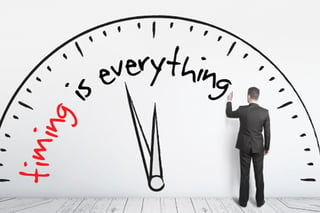 Last week I wrote about the timing of filing a bankruptcy case when determining how to know if you should file bankruptcy. The focus of that was when to file in the context of the collection process - filing to avoid the execution
Last week I wrote about the timing of filing a bankruptcy case when determining how to know if you should file bankruptcy. The focus of that was when to file in the context of the collection process - filing to avoid the execution
Let ’s look at what the Bankruptcy Code has to say about when a debtor can file a bankruptcy case.
There are two timing requirements in the Bankruptcy Code: the first is eligibility for a discharge, the second is a question of timing as it relates to the venue in which the bankruptcy case is filed.
The first timing question has to do with a debtor’s eligibility to receive a bankruptcy discharge. The Bankruptcy Code is drafted to give individuals protection and to discharge
The time period is shorter (six years) if the person filing a chapter 7 case received a discharge in a chapter 13 case. There is an exception to the rule that a Chapter 7 debtor will not receive a discharge if there was a recent chapter 13 case that resulted in a discharge. That is when the previous Chapter 13 case and in the Chapter 13 case 100% of all the unsecured claims in the chapter 13 case were paid, or a minimum of 70% of the unsecured claims were paid and the debtor filed the chapter 13 case in good faith and the payment represented the debtor’s best effort to pay his or her debt.
There are time limits that affect the ability of a Chapter 13 debtor to receive a discharge, but the time limits are shorter than those found in chapter 7. To receive a Chapter 13 discharge, the Chapter 13 debtor must not have filed a Chapter 7 case for which he or she received a discharge less than four years before filing the present chapter 13 case. And a chapter 13 debtor must wait two years after filing a previous chapter 13 case that resulted in discharge in order to receive a discharge in the present case.
A lot of Bankruptcy Lawyers in Minneapolis think it’s highly likely Congress made a mistake when it set the two-year time limit for chapter 13 discharges following a previous chapter 13
There’s an important point to remember here:
What I’ve just written applies to individuals receiving a discharge at the end of a bankruptcy case. There’s nothing in the bankruptcy code that prevents an individual from filing a bankruptcy case, even if that person knows that he or she will be ineligible for a discharge. Filing a chapter 7 case when no discharge is going to be forthcoming is not recommended. Chapter 7 cases last for three or four months, and if a person files a chapter 7 case and a discharge is prohibited by the Bankruptcy Code, that person can expect to receive a motion to dismiss the chapter 7 case from the US Trustee’s office shortly after filing.
However, that is not the case when an individual files a chapter 13 case. If a person files a chapter 13 case when that person is not eligible for a chapter 13 discharge, the Us Trustee’s office will not bring a motion to dismiss. Rather, the chapter 13 trustee will bring an adversary proceeding against the chapter 13 debtor to determine that the chapter 13 debtor is not entitled to a discharge. There’s a major difference. The chapter 7 debtor who will not receive a discharge is subject to be “kicked out” of his or her chapter 7 case as soon the US Trustee can draft the motion. Chapter 13 doesn’t work like that. If a repeat filer needs to file a chapter 13, then that person can remain in his or her chapter 13, with the protection of the automatic stay, until the three-to-five year plan has been completed.
Why would a debtor choose to file a chapter 13 case when no discharge will be granted?
Realistically, this situation doesn’t come up very often, but it does occasionally. We
That is one fact situation, but the most common use of chapter 13 in a case in which there will be no discharge is if a client is looking
There are two other timing issues that come up frequently.
Both involve problems with secured debts - namely home mortgages and car loans. When a person defaults on a mortgage, there is a statutory procedure that is strictly enforced before a mortgage company can foreclose on real estate. And if the real estate in question is a person’s home, then there are additional requirements that mortgage companies must follow before the house can be sold at a sheriff’s foreclosure auction and eventually sold by the mortgage company. Filing a bankruptcy case will affect the foreclosure process in significant ways, but it is important to understand the difference in the way mortgage default is handled in a chapter 7 case and the way default is handled in a chapter 13 case.
When a mortgage payment is missed, almost all mortgage companies will simply contact mortgage payers (mortgagors) to ask for payment. When the missed payment is small, mortgage companies will usually try to work informally with mortgagors to catch up on the back payments.
In order to foreclose on a home in Minnesota, one of two things must happen: the most common is that the Minneapolis Bankruptcy Lawyer must serve the mortgagors with a notice of a mortgage foreclosure sale, identifying the property in question, the mortgage company foreclosing on the property and the date, time and location of the mortgage foreclosure sale
There’s a significant difference in outcome of a mortgage foreclosure if a person files a chapter 7, or a chapter 13 case.
In either a chapter 7 or chapter 13 case, if a person files a bankruptcy case prior to a foreclosure sale taking place, the automatic stay issued by the bankruptcy court when a bankruptcy case is filed will in effect postpone the foreclosure sale. While a bankruptcy case is pending, no creditors, whether secured, like a mortgage company, or unsecured can take any action to collect a debt. So whether a person files a chapter 7 or a chapter 13 case, the immediate issue - the mortgage foreclosure sale - is resolved, since the foreclosure sale cannot be held while a bankruptcy case is pending.
There is a difference between chapter 7 cases and chapter 13 cases with what happens next, though. In a chapter 7 case, there is no mechanism in the bankruptcy case itself to resolve the underlying issue that prompted the mortgage foreclosure sale - that is, the default in payments that took place prior to the case being filed. A chapter 7 debtor can “cancel” a pending foreclosure sale by filing a bankruptcy case, but that is the extent of the protection a chapter 7 bankruptcy case holds. Unless the chapter 7 debtor can come up with the money to become current while the chapter 7 case is pending, the mortgage company will simply re-start the foreclosure proceeding after the chapter 7 case is discharged.
And while it is not common, a mortgage company that had a foreclosure pending at the time a chapter 7 case was filed has the option of asking the bankruptcy court to lift the automatic stay protection that prevents a mortgage foreclosure sale from taking place while the case is pending, provided that the default has continued into the bankruptcy case. This is
A chapter 13 bankruptcy case is different. In a chapter 13 case, a debtor in default on a mortgage can propose to pay the amount in default on the mortgage over a three to five year time period. Chapter 13 is a tremendous tool for people to use who have fallen behind on their mortgage payments and who want to stay in their home. Filing a chapter 13 offers hope to homeowners who have a realistic budget that allows them to continue to make their ongoing house payments while also paying enough money each month to a bankruptcy trustee to make up the arrears on the mortgage.
Timing the filing of
100 South Fifth Street #1900
Minneapolis, MN 55402
(612) 843-0527
info@kainscott.com


